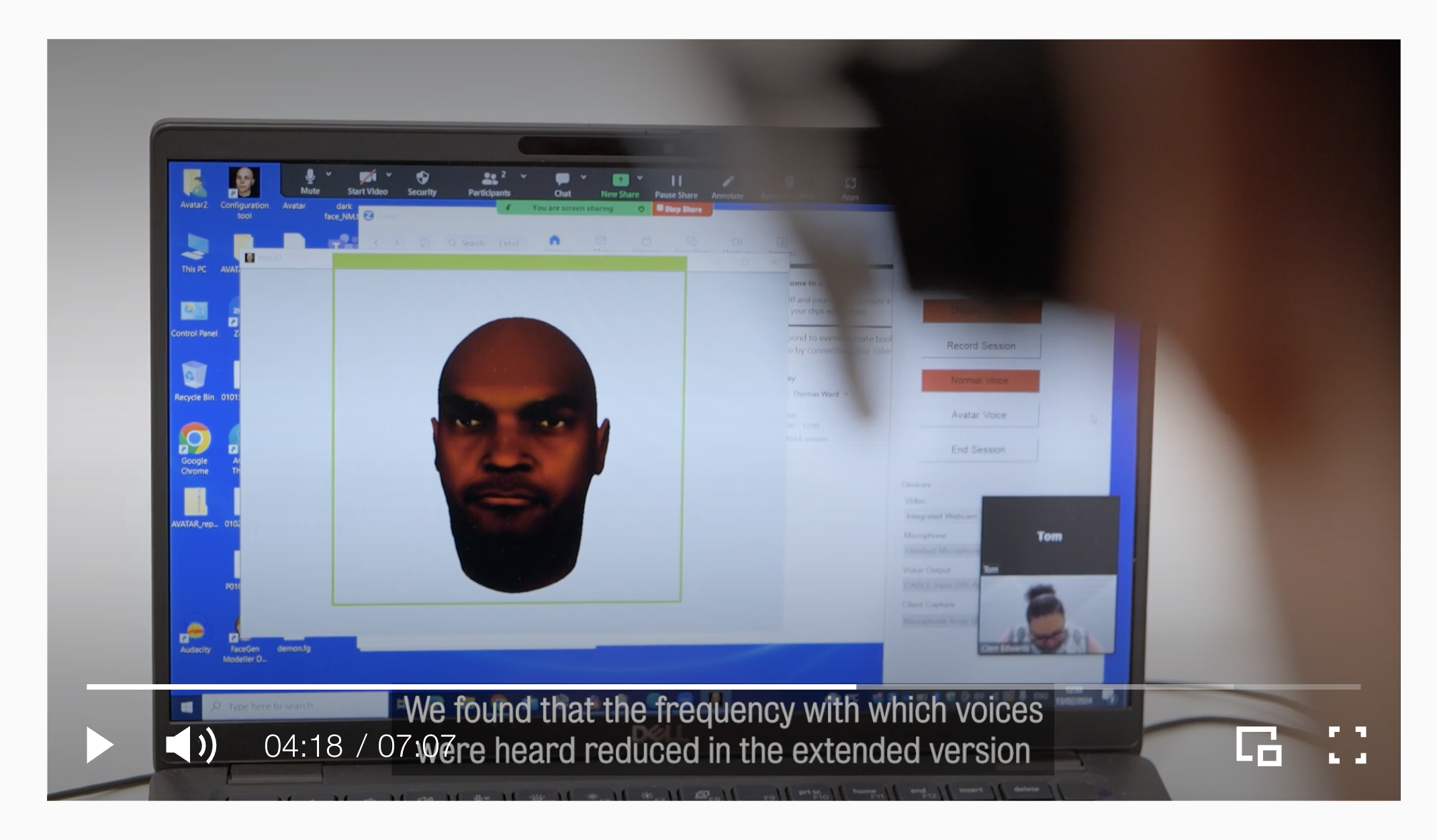Forget creepy apps and bots. This is the future of mental health technology we need.
A radical aid for people who hear distressing voices.

Please support me by picking up a paid subscription via the links at the end of the article.
Technological innovations in mental health have become synonymous with apps, chatbots, and generative AI mousetraps, many of which have been exposed as abusing patient data, making misleading clinical claims, even pushing users to suicide.
What if there existed a technology without this creepy underside, one that could actually help relieve one of the most debilitating symptoms of a highly stigmatised condition: distressing voices experienced by people living with schizophrenia?
That's the work psychiatrist Julian Leff started in 2008. Leff, who spent three decades at the Institute of Psychiatry in London's Maudsley Hospital, was moved by a survey that showed that the most distressing feeling among people who heard voices was the feeling of helplessness.
“I thought, that's not surprising, because the voices are invisible. So I wondered, what if we could give them a face?”
Leff asked IT and virtual reality researchers at his alma mater and former employer University College London for help. They turned to police identikit technology and voice modification software, and together with people who heard voices, they created visual avatars representing these voices.
Leff then sat behind a screen and started talking to the patients both in his own voice as a therapist and as the malevolent avatar. The first man who tried it came to his next appointment saying the voice had disappeared. "It's as though she's left the room."
"It gave me quite an eerie feeling that it had worked," Leff said. The experiment had "surpassed my wildest dreams."
In 2013, Leff revealed the results of a pilot study with 26 patients, which showed a reduction in the frequency of hearing voices as well as the distress caused by them. Five years later, AVATAR 1, a randomised control trial with 150 participants divided between Avatar Therapy and supportive counselling, showed less severity of voices among the former set in 12 weeks, and effects larger than existing therapies.
Leff passed away in 2021. That same year the therapy went into a bigger, multi-site study in the UK, featuring two versions: AVATAR Brief (six sessions) and AVATAR Extended (12 sessions). The study results were published last year. They showed a rapid reduction in the distress the voices caused. The frequency of the voices was reduced in the extended version. Patients also felt more empowered in relation to the voices and reported improved wellbeing. The therapy has since been recommended for use in the UK's National Health Services.
"When we talk about voices and visions, we simply mean someone is hearing, seeing or sensing something that others around them aren’t. These experiences can include all five senses, hearing, sight, smell, taste and touch. These experiences can occur in one sense at a time (hearing a voice, for example, or smelling something), but they can also happen in combination.
"For some, these experiences can be comforting. For example, someone who is lonely may really value a voice that becomes a trusted confidant. A person who has recently lost someone they care about may benefit from talking to them at the end of the day, or smelling their perfume/aftershave. Others find these experiences to be a source of inspiration. Authors, for example, sometimes talk about how the characters can come to life and write the story for them. However, for some people these voices and visions can be extremely distressing – criticising, threatening or causing confusion."
Source: Hearing Voices Network
One of the patients who participated in the trial, Natalie, would hear a voice that said, "If you go out, the car will hit you." Here's a sample of the conversation Natalie had with the therapist and the avatar:
Therapist: "Just remind me. What's the key, strong, powerful statement you want to get across today?"
Natalie: "[Takes a deep breath] Tell him that I can do it, and that he needs to stop bullying me."
Therapist: "Absolutely. Okay, brilliant. The next thing you are going to hear is going to be the Avatar."
Avatar to Natalie: "No one wants you to be around. Stay in your room."
Natalie: "You can't tell me what to do anymore. I am going to try and go out and be myself."
Avatar: "You what?"
Natalie: "Yea, you heard me. I am going to go out and do what I want to do. Because you are nothing but a big bully."
"It literally changed my life," Natalie says about the therapy in this video.

In another study in Denmark, results of an Avatar-based virtual reality system called Challenge-VRT among 271 patients showed that it significantly reduced the severity of auditory hallucinations compared to enhanced treatment-as-usual.
Helena Blažinčić, project manager - clinical trials at Heka VR, the company that developed the technology, said in response to my social media post that these were all "treatment-resistant" patients, and that the tech is now being rolled out across Denmark to enable Avatar therapy setup for clinicians. The company believes that the technology could also be useful in PTSD, eating disorders (subject of a clinical trial in association with the University of Copenhagen), bipolar disorder, borderline disorder, and severe depression.
The main element of the Avatar Therapy software is an artificial 3D computer graphics persona that can be customised by the client and used in a dialogue between therapist and client. The avatar is created by the therapist and client together in an initial enrolment session. The customised avatar is then stored as a combination of a voice transform and a 3D head model to be used in future therapy sessions.
What does a session look like?
During a therapy session, the avatar system runs on two computers in two separate locations. The therapist operates one copy of the system and can speak through the system to the client at the other location, either in their normal voice or in the avatar voice. The client can see the avatar and hear the therapist's voice or the avatar's voice. The mouth movements of the avatar are synchronised to match the clinician's voice and create the illusion that it is the avatar speaking. The therapist can also see the client's visual. After each session, the client can get a recording of the dialogue between themself, the therapist, and the avatar so that they can listen to it again outside the session.
Source: https://www.avatartherapy.co.uk/
More details on the software here.
Research in non-western settings a critical need
In the UK, over 600,000 people are estimated to develop schizophrenia. Globally, approximately 23 million people live with the condition. Reliable estimates of the burden of schizophrenia in low- and middle-income countries are hard to find, but research suggests that in developing countries, 90% of the people with the disorder receive no treatment. In India, 3.5 million people were said to be living with the condition in 2017. It had the fourth highest contribution to disability-adjusted life years (DALY) among mental disorders.
People with schizophrenia die nine years earlier than the general population, reports the WHO. They often experience human rights violations, both inside mental health institutions and in community settings, and face widespread social exclusion and discrimination, which in turn can limit access to health care, education, housing, and employment.
Can Avatar Therapy be transplanted in LMIC settings via technology transfer and capacity building, I asked Philippa Garety and Thomas Ward of King's College London, who led the AVATAR 2 study, and Miranda Wolpert, head of mental health at Wellcome Trust which funded the study. At the time of writing I was yet to hear back from them. I will update this piece when I receive their responses.
Meanwhile, the therapy offers "a promising way of entering the lived reality of a patient with psychosis and then intervening," said psychotherapist Srishti A Bisht, who wrote a college dissertation on Avatar Therapy.
"Many times any form of intervention beyond rehabilitative work, pharmacotherapy, and maybe some psychoeducation for family is not at all seen," Srishti added. "I have heard many cases of psychiatrists straight away saying to [a] patient's family that there is no need to involve a therapist of any kind. I feel Avatar Therapy is [the] window which we are missing out [on] due to the general perception that schizophrenia is only treatable by medicine (barely leaving room for even rehabilitative work)."
Pharma, biotech, and life sciences consultant Samik Das said,"It will be good to have a long-term trial to see if the delusions associated with the voices get transferred to delusions associated with the avatar. But in the short term in severe distress, the logic of the Avatar [Therapy] seems reasonable to me."
Samik added a hopeful note on what the flavour of the season, AI chatbots, can take away from the success of Avatar Therapy.
"I think the evidence behind this clinical Avatar Therapy also provides some 'evidence' on why AI chatbot therapy will work. While a person in psychosis has auditory voices in mind, we have a lot of non-auditory 'voices in our mind' which are not 'good', for which we go to a therapist. If a well-tuned machine avatar can solve for auditory hallucinations, a well-tuned AI chatbot should be able to solve for more general issues of the mind. With the same caveat that long-term delusions about the chatbot is possible."
We need more research on potential adverse effects of the technology, and on its efficacy in non-western settings. But for now, Avatar Therapy offers a glimpse into what mental health technology beyond apps and bots can achieve. Now there's a sweet sound.
This piece has been updated with the potential use cases of Heka VR's technology beyond schizophrenia.
Read more
This is an excellent essay on why we shouldn't call false responses sometimes churned out by AI bots 'hallucinations'.





